Effective Business Communication: Diagnostic Tools and Communication Issues
VerifiedAdded on 2023/06/11
|19
|5080
|497
AI Summary
This report discusses the skills of communication using five diagnostic tools and presents two communication issues. It includes a literature review and an action plan to improve communication skills.
Contribute Materials
Your contribution can guide someone’s learning journey. Share your
documents today.

Running head: EFFECTIVE BUSINESS COMMUNICATION
Effective Business Communication
Effective Business Communication
Secure Best Marks with AI Grader
Need help grading? Try our AI Grader for instant feedback on your assignments.
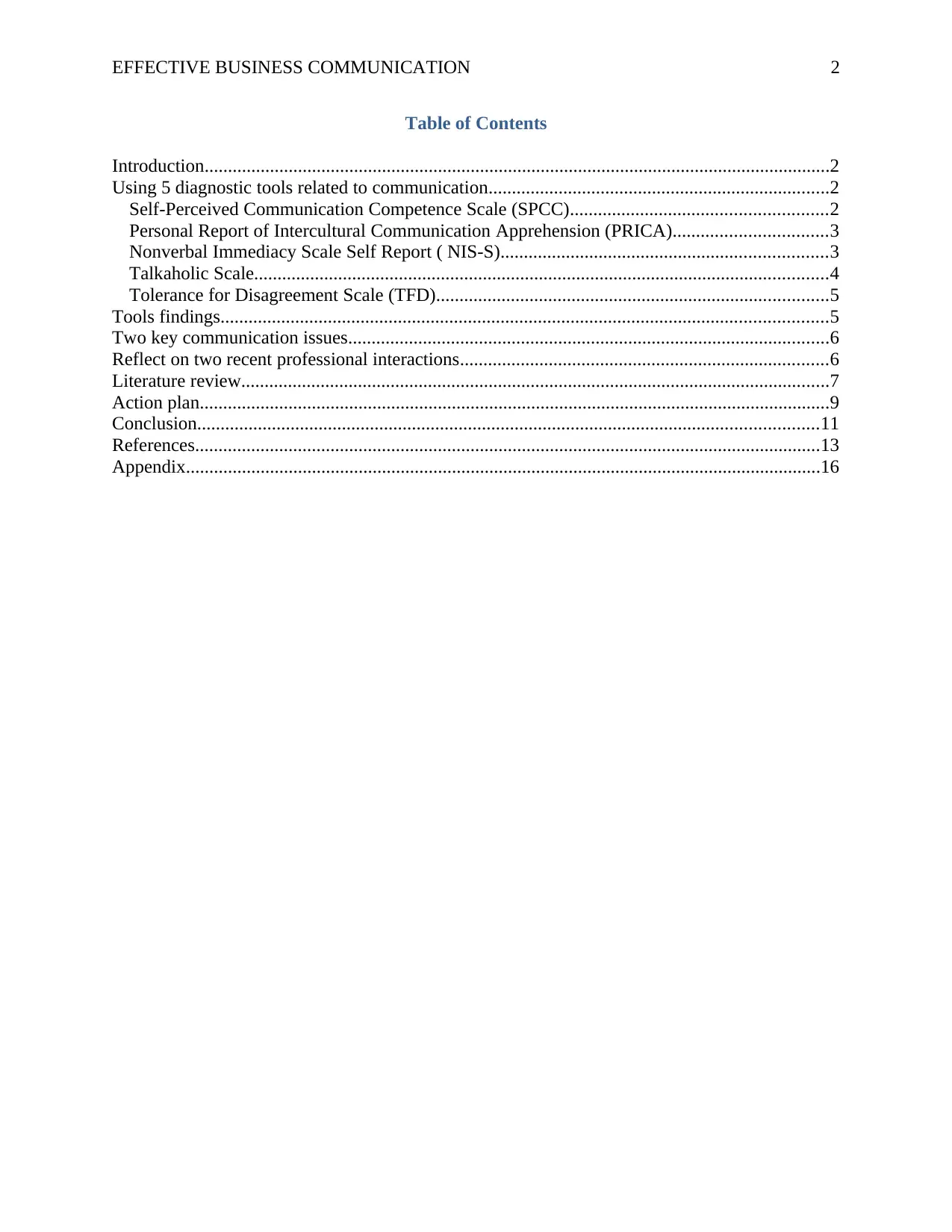
EFFECTIVE BUSINESS COMMUNICATION 2
Table of Contents
Introduction......................................................................................................................................2
Using 5 diagnostic tools related to communication.........................................................................2
Self-Perceived Communication Competence Scale (SPCC).......................................................2
Personal Report of Intercultural Communication Apprehension (PRICA).................................3
Nonverbal Immediacy Scale Self Report ( NIS-S)......................................................................3
Talkaholic Scale...........................................................................................................................4
Tolerance for Disagreement Scale (TFD)....................................................................................5
Tools findings..................................................................................................................................5
Two key communication issues.......................................................................................................6
Reflect on two recent professional interactions...............................................................................6
Literature review..............................................................................................................................7
Action plan.......................................................................................................................................9
Conclusion.....................................................................................................................................11
References......................................................................................................................................13
Appendix........................................................................................................................................16
Table of Contents
Introduction......................................................................................................................................2
Using 5 diagnostic tools related to communication.........................................................................2
Self-Perceived Communication Competence Scale (SPCC).......................................................2
Personal Report of Intercultural Communication Apprehension (PRICA).................................3
Nonverbal Immediacy Scale Self Report ( NIS-S)......................................................................3
Talkaholic Scale...........................................................................................................................4
Tolerance for Disagreement Scale (TFD)....................................................................................5
Tools findings..................................................................................................................................5
Two key communication issues.......................................................................................................6
Reflect on two recent professional interactions...............................................................................6
Literature review..............................................................................................................................7
Action plan.......................................................................................................................................9
Conclusion.....................................................................................................................................11
References......................................................................................................................................13
Appendix........................................................................................................................................16
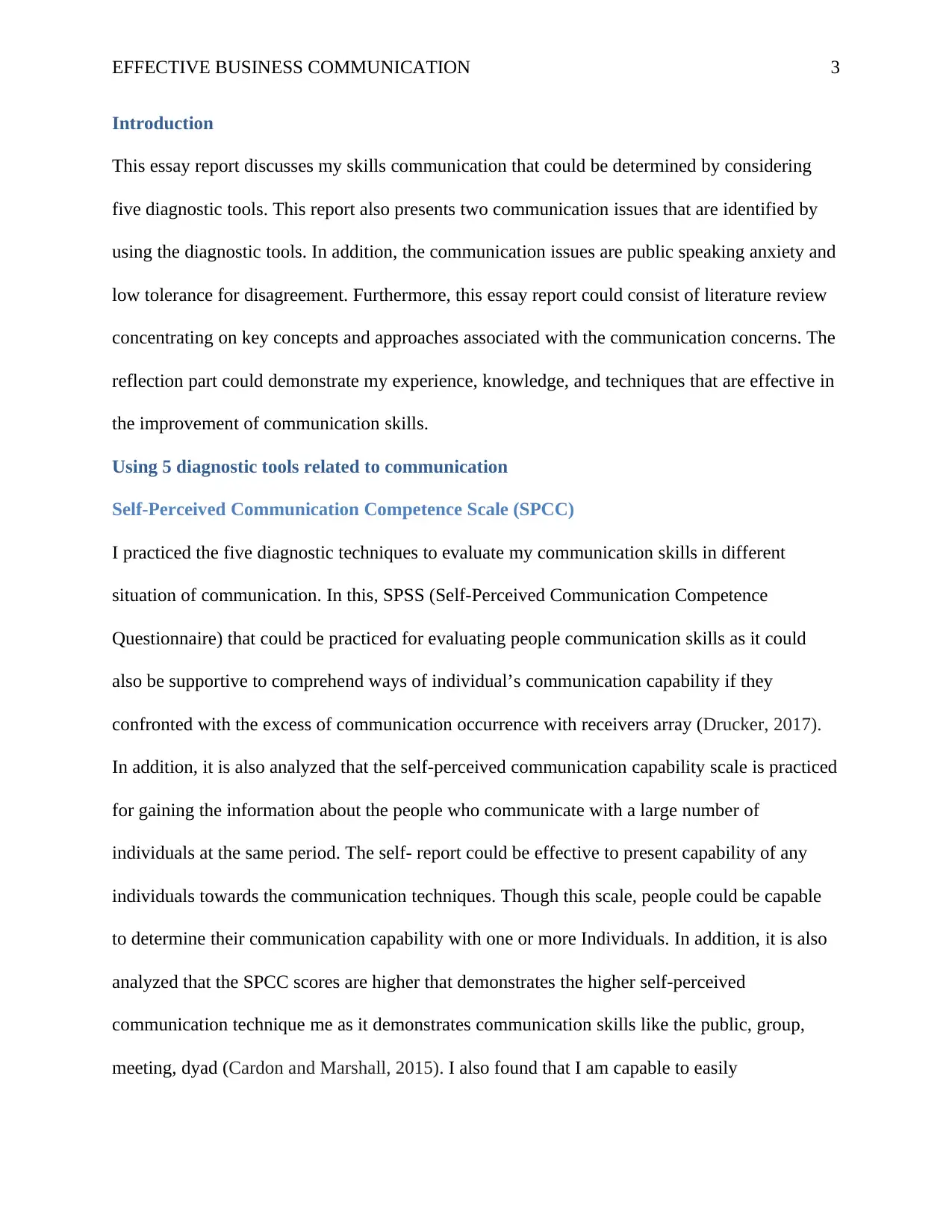
EFFECTIVE BUSINESS COMMUNICATION 3
Introduction
This essay report discusses my skills communication that could be determined by considering
five diagnostic tools. This report also presents two communication issues that are identified by
using the diagnostic tools. In addition, the communication issues are public speaking anxiety and
low tolerance for disagreement. Furthermore, this essay report could consist of literature review
concentrating on key concepts and approaches associated with the communication concerns. The
reflection part could demonstrate my experience, knowledge, and techniques that are effective in
the improvement of communication skills.
Using 5 diagnostic tools related to communication
Self-Perceived Communication Competence Scale (SPCC)
I practiced the five diagnostic techniques to evaluate my communication skills in different
situation of communication. In this, SPSS (Self-Perceived Communication Competence
Questionnaire) that could be practiced for evaluating people communication skills as it could
also be supportive to comprehend ways of individual’s communication capability if they
confronted with the excess of communication occurrence with receivers array (Drucker, 2017).
In addition, it is also analyzed that the self-perceived communication capability scale is practiced
for gaining the information about the people who communicate with a large number of
individuals at the same period. The self- report could be effective to present capability of any
individuals towards the communication techniques. Though this scale, people could be capable
to determine their communication capability with one or more Individuals. In addition, it is also
analyzed that the SPCC scores are higher that demonstrates the higher self-perceived
communication technique me as it demonstrates communication skills like the public, group,
meeting, dyad (Cardon and Marshall, 2015). I also found that I am capable to easily
Introduction
This essay report discusses my skills communication that could be determined by considering
five diagnostic tools. This report also presents two communication issues that are identified by
using the diagnostic tools. In addition, the communication issues are public speaking anxiety and
low tolerance for disagreement. Furthermore, this essay report could consist of literature review
concentrating on key concepts and approaches associated with the communication concerns. The
reflection part could demonstrate my experience, knowledge, and techniques that are effective in
the improvement of communication skills.
Using 5 diagnostic tools related to communication
Self-Perceived Communication Competence Scale (SPCC)
I practiced the five diagnostic techniques to evaluate my communication skills in different
situation of communication. In this, SPSS (Self-Perceived Communication Competence
Questionnaire) that could be practiced for evaluating people communication skills as it could
also be supportive to comprehend ways of individual’s communication capability if they
confronted with the excess of communication occurrence with receivers array (Drucker, 2017).
In addition, it is also analyzed that the self-perceived communication capability scale is practiced
for gaining the information about the people who communicate with a large number of
individuals at the same period. The self- report could be effective to present capability of any
individuals towards the communication techniques. Though this scale, people could be capable
to determine their communication capability with one or more Individuals. In addition, it is also
analyzed that the SPCC scores are higher that demonstrates the higher self-perceived
communication technique me as it demonstrates communication skills like the public, group,
meeting, dyad (Cardon and Marshall, 2015). I also found that I am capable to easily
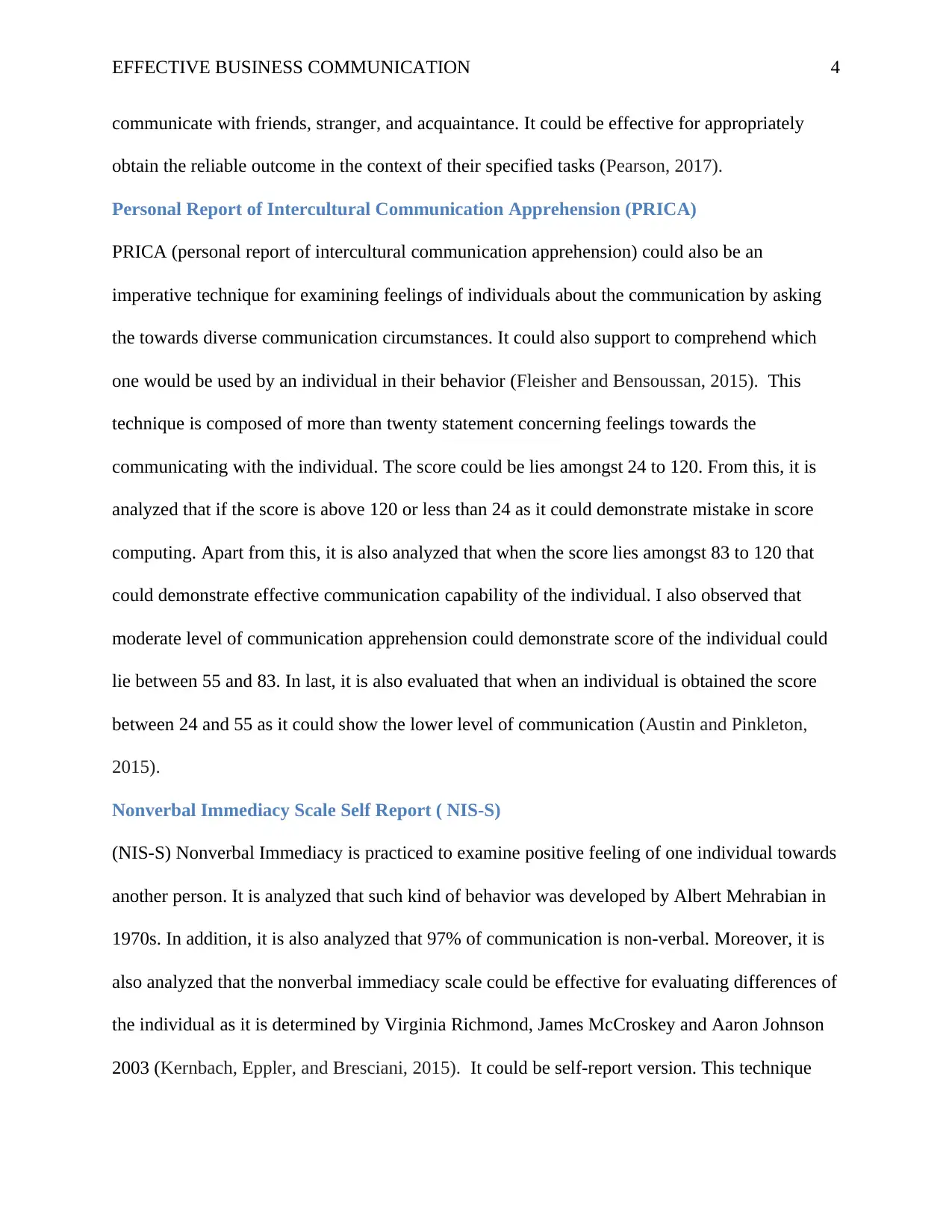
EFFECTIVE BUSINESS COMMUNICATION 4
communicate with friends, stranger, and acquaintance. It could be effective for appropriately
obtain the reliable outcome in the context of their specified tasks (Pearson, 2017).
Personal Report of Intercultural Communication Apprehension (PRICA)
PRICA (personal report of intercultural communication apprehension) could also be an
imperative technique for examining feelings of individuals about the communication by asking
the towards diverse communication circumstances. It could also support to comprehend which
one would be used by an individual in their behavior (Fleisher and Bensoussan, 2015). This
technique is composed of more than twenty statement concerning feelings towards the
communicating with the individual. The score could be lies amongst 24 to 120. From this, it is
analyzed that if the score is above 120 or less than 24 as it could demonstrate mistake in score
computing. Apart from this, it is also analyzed that when the score lies amongst 83 to 120 that
could demonstrate effective communication capability of the individual. I also observed that
moderate level of communication apprehension could demonstrate score of the individual could
lie between 55 and 83. In last, it is also evaluated that when an individual is obtained the score
between 24 and 55 as it could show the lower level of communication (Austin and Pinkleton,
2015).
Nonverbal Immediacy Scale Self Report ( NIS-S)
(NIS-S) Nonverbal Immediacy is practiced to examine positive feeling of one individual towards
another person. It is analyzed that such kind of behavior was developed by Albert Mehrabian in
1970s. In addition, it is also analyzed that 97% of communication is non-verbal. Moreover, it is
also analyzed that the nonverbal immediacy scale could be effective for evaluating differences of
the individual as it is determined by Virginia Richmond, James McCroskey and Aaron Johnson
2003 (Kernbach, Eppler, and Bresciani, 2015). It could be self-report version. This technique
communicate with friends, stranger, and acquaintance. It could be effective for appropriately
obtain the reliable outcome in the context of their specified tasks (Pearson, 2017).
Personal Report of Intercultural Communication Apprehension (PRICA)
PRICA (personal report of intercultural communication apprehension) could also be an
imperative technique for examining feelings of individuals about the communication by asking
the towards diverse communication circumstances. It could also support to comprehend which
one would be used by an individual in their behavior (Fleisher and Bensoussan, 2015). This
technique is composed of more than twenty statement concerning feelings towards the
communicating with the individual. The score could be lies amongst 24 to 120. From this, it is
analyzed that if the score is above 120 or less than 24 as it could demonstrate mistake in score
computing. Apart from this, it is also analyzed that when the score lies amongst 83 to 120 that
could demonstrate effective communication capability of the individual. I also observed that
moderate level of communication apprehension could demonstrate score of the individual could
lie between 55 and 83. In last, it is also evaluated that when an individual is obtained the score
between 24 and 55 as it could show the lower level of communication (Austin and Pinkleton,
2015).
Nonverbal Immediacy Scale Self Report ( NIS-S)
(NIS-S) Nonverbal Immediacy is practiced to examine positive feeling of one individual towards
another person. It is analyzed that such kind of behavior was developed by Albert Mehrabian in
1970s. In addition, it is also analyzed that 97% of communication is non-verbal. Moreover, it is
also analyzed that the nonverbal immediacy scale could be effective for evaluating differences of
the individual as it is determined by Virginia Richmond, James McCroskey and Aaron Johnson
2003 (Kernbach, Eppler, and Bresciani, 2015). It could be self-report version. This technique
Secure Best Marks with AI Grader
Need help grading? Try our AI Grader for instant feedback on your assignments.
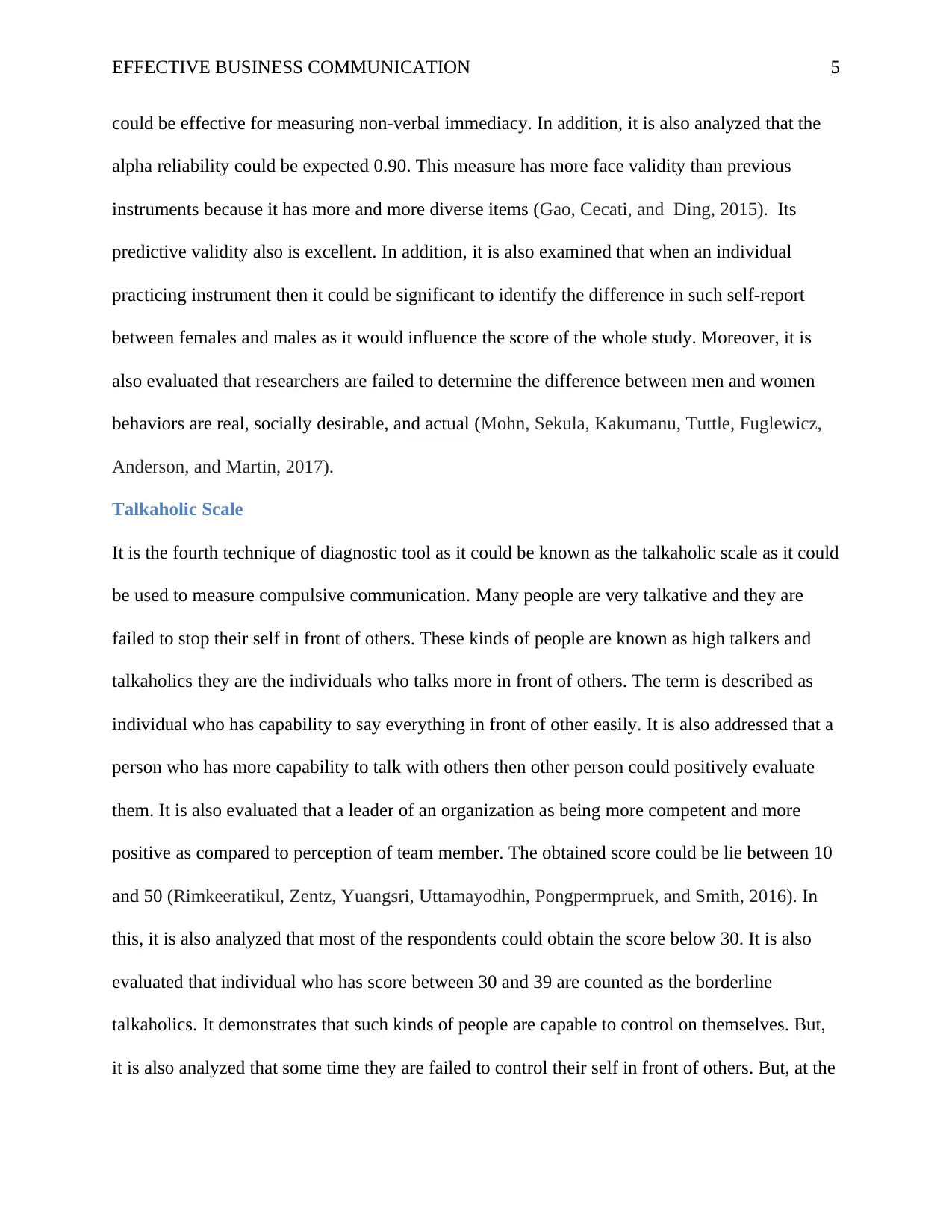
EFFECTIVE BUSINESS COMMUNICATION 5
could be effective for measuring non-verbal immediacy. In addition, it is also analyzed that the
alpha reliability could be expected 0.90. This measure has more face validity than previous
instruments because it has more and more diverse items (Gao, Cecati, and Ding, 2015). Its
predictive validity also is excellent. In addition, it is also examined that when an individual
practicing instrument then it could be significant to identify the difference in such self-report
between females and males as it would influence the score of the whole study. Moreover, it is
also evaluated that researchers are failed to determine the difference between men and women
behaviors are real, socially desirable, and actual (Mohn, Sekula, Kakumanu, Tuttle, Fuglewicz,
Anderson, and Martin, 2017).
Talkaholic Scale
It is the fourth technique of diagnostic tool as it could be known as the talkaholic scale as it could
be used to measure compulsive communication. Many people are very talkative and they are
failed to stop their self in front of others. These kinds of people are known as high talkers and
talkaholics they are the individuals who talks more in front of others. The term is described as
individual who has capability to say everything in front of other easily. It is also addressed that a
person who has more capability to talk with others then other person could positively evaluate
them. It is also evaluated that a leader of an organization as being more competent and more
positive as compared to perception of team member. The obtained score could be lie between 10
and 50 (Rimkeeratikul, Zentz, Yuangsri, Uttamayodhin, Pongpermpruek, and Smith, 2016). In
this, it is also analyzed that most of the respondents could obtain the score below 30. It is also
evaluated that individual who has score between 30 and 39 are counted as the borderline
talkaholics. It demonstrates that such kinds of people are capable to control on themselves. But,
it is also analyzed that some time they are failed to control their self in front of others. But, at the
could be effective for measuring non-verbal immediacy. In addition, it is also analyzed that the
alpha reliability could be expected 0.90. This measure has more face validity than previous
instruments because it has more and more diverse items (Gao, Cecati, and Ding, 2015). Its
predictive validity also is excellent. In addition, it is also examined that when an individual
practicing instrument then it could be significant to identify the difference in such self-report
between females and males as it would influence the score of the whole study. Moreover, it is
also evaluated that researchers are failed to determine the difference between men and women
behaviors are real, socially desirable, and actual (Mohn, Sekula, Kakumanu, Tuttle, Fuglewicz,
Anderson, and Martin, 2017).
Talkaholic Scale
It is the fourth technique of diagnostic tool as it could be known as the talkaholic scale as it could
be used to measure compulsive communication. Many people are very talkative and they are
failed to stop their self in front of others. These kinds of people are known as high talkers and
talkaholics they are the individuals who talks more in front of others. The term is described as
individual who has capability to say everything in front of other easily. It is also addressed that a
person who has more capability to talk with others then other person could positively evaluate
them. It is also evaluated that a leader of an organization as being more competent and more
positive as compared to perception of team member. The obtained score could be lie between 10
and 50 (Rimkeeratikul, Zentz, Yuangsri, Uttamayodhin, Pongpermpruek, and Smith, 2016). In
this, it is also analyzed that most of the respondents could obtain the score below 30. It is also
evaluated that individual who has score between 30 and 39 are counted as the borderline
talkaholics. It demonstrates that such kinds of people are capable to control on themselves. But,
it is also analyzed that some time they are failed to control their self in front of others. But, at the
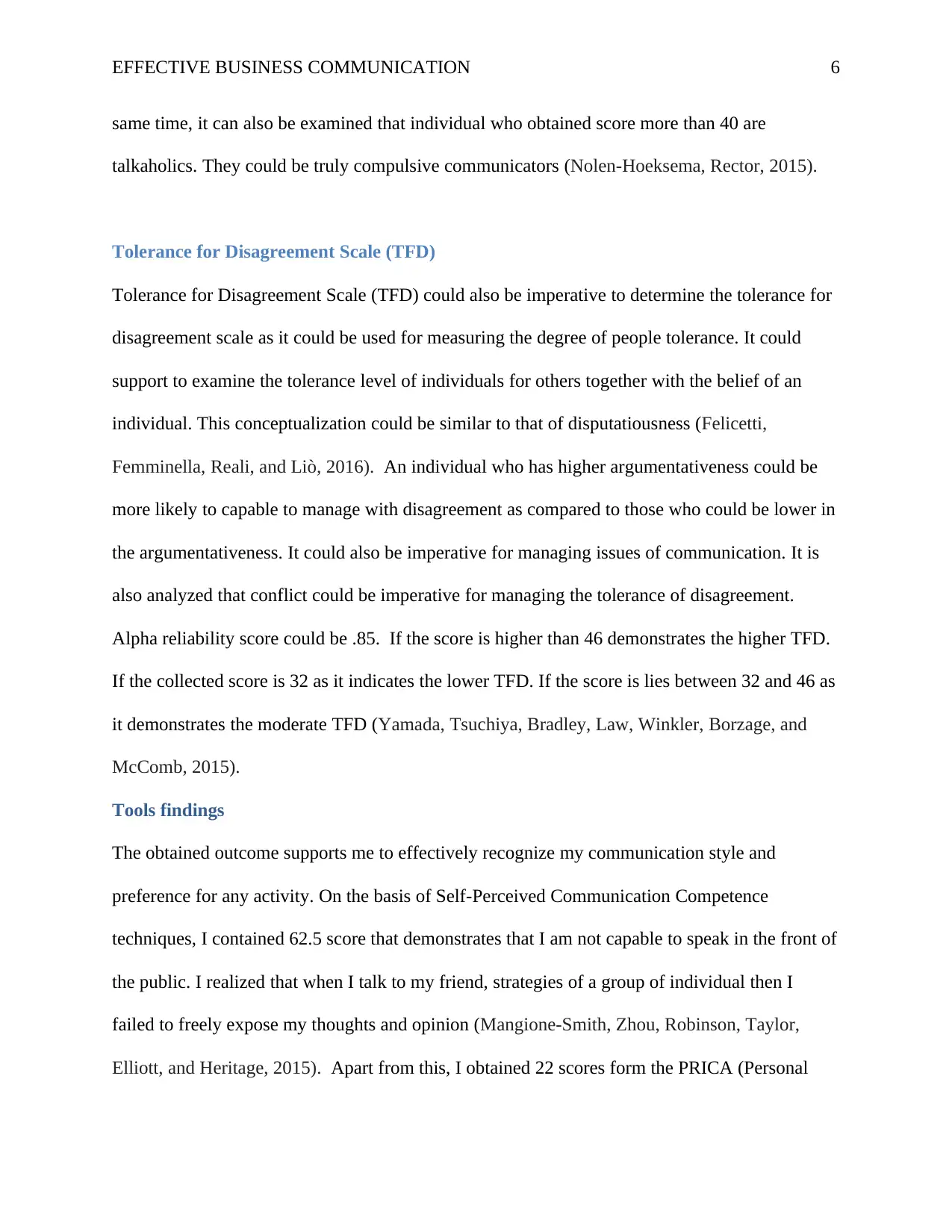
EFFECTIVE BUSINESS COMMUNICATION 6
same time, it can also be examined that individual who obtained score more than 40 are
talkaholics. They could be truly compulsive communicators (Nolen-Hoeksema, Rector, 2015).
Tolerance for Disagreement Scale (TFD)
Tolerance for Disagreement Scale (TFD) could also be imperative to determine the tolerance for
disagreement scale as it could be used for measuring the degree of people tolerance. It could
support to examine the tolerance level of individuals for others together with the belief of an
individual. This conceptualization could be similar to that of disputatiousness (Felicetti,
Femminella, Reali, and Liò, 2016). An individual who has higher argumentativeness could be
more likely to capable to manage with disagreement as compared to those who could be lower in
the argumentativeness. It could also be imperative for managing issues of communication. It is
also analyzed that conflict could be imperative for managing the tolerance of disagreement.
Alpha reliability score could be .85. If the score is higher than 46 demonstrates the higher TFD.
If the collected score is 32 as it indicates the lower TFD. If the score is lies between 32 and 46 as
it demonstrates the moderate TFD (Yamada, Tsuchiya, Bradley, Law, Winkler, Borzage, and
McComb, 2015).
Tools findings
The obtained outcome supports me to effectively recognize my communication style and
preference for any activity. On the basis of Self-Perceived Communication Competence
techniques, I contained 62.5 score that demonstrates that I am not capable to speak in the front of
the public. I realized that when I talk to my friend, strategies of a group of individual then I
failed to freely expose my thoughts and opinion (Mangione-Smith, Zhou, Robinson, Taylor,
Elliott, and Heritage, 2015). Apart from this, I obtained 22 scores form the PRICA (Personal
same time, it can also be examined that individual who obtained score more than 40 are
talkaholics. They could be truly compulsive communicators (Nolen-Hoeksema, Rector, 2015).
Tolerance for Disagreement Scale (TFD)
Tolerance for Disagreement Scale (TFD) could also be imperative to determine the tolerance for
disagreement scale as it could be used for measuring the degree of people tolerance. It could
support to examine the tolerance level of individuals for others together with the belief of an
individual. This conceptualization could be similar to that of disputatiousness (Felicetti,
Femminella, Reali, and Liò, 2016). An individual who has higher argumentativeness could be
more likely to capable to manage with disagreement as compared to those who could be lower in
the argumentativeness. It could also be imperative for managing issues of communication. It is
also analyzed that conflict could be imperative for managing the tolerance of disagreement.
Alpha reliability score could be .85. If the score is higher than 46 demonstrates the higher TFD.
If the collected score is 32 as it indicates the lower TFD. If the score is lies between 32 and 46 as
it demonstrates the moderate TFD (Yamada, Tsuchiya, Bradley, Law, Winkler, Borzage, and
McComb, 2015).
Tools findings
The obtained outcome supports me to effectively recognize my communication style and
preference for any activity. On the basis of Self-Perceived Communication Competence
techniques, I contained 62.5 score that demonstrates that I am not capable to speak in the front of
the public. I realized that when I talk to my friend, strategies of a group of individual then I
failed to freely expose my thoughts and opinion (Mangione-Smith, Zhou, Robinson, Taylor,
Elliott, and Heritage, 2015). Apart from this, I obtained 22 scores form the PRICA (Personal
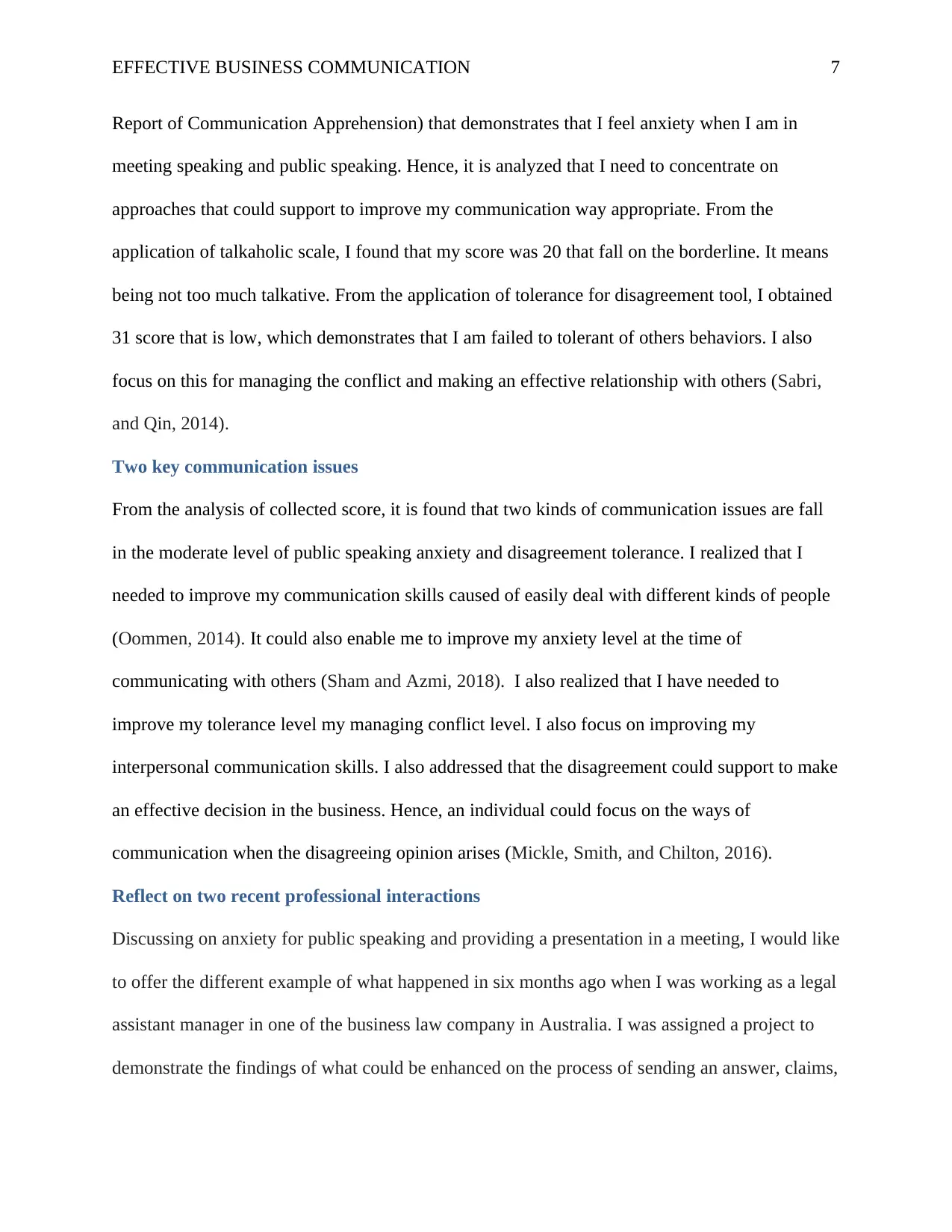
EFFECTIVE BUSINESS COMMUNICATION 7
Report of Communication Apprehension) that demonstrates that I feel anxiety when I am in
meeting speaking and public speaking. Hence, it is analyzed that I need to concentrate on
approaches that could support to improve my communication way appropriate. From the
application of talkaholic scale, I found that my score was 20 that fall on the borderline. It means
being not too much talkative. From the application of tolerance for disagreement tool, I obtained
31 score that is low, which demonstrates that I am failed to tolerant of others behaviors. I also
focus on this for managing the conflict and making an effective relationship with others (Sabri,
and Qin, 2014).
Two key communication issues
From the analysis of collected score, it is found that two kinds of communication issues are fall
in the moderate level of public speaking anxiety and disagreement tolerance. I realized that I
needed to improve my communication skills caused of easily deal with different kinds of people
(Oommen, 2014). It could also enable me to improve my anxiety level at the time of
communicating with others (Sham and Azmi, 2018). I also realized that I have needed to
improve my tolerance level my managing conflict level. I also focus on improving my
interpersonal communication skills. I also addressed that the disagreement could support to make
an effective decision in the business. Hence, an individual could focus on the ways of
communication when the disagreeing opinion arises (Mickle, Smith, and Chilton, 2016).
Reflect on two recent professional interactions
Discussing on anxiety for public speaking and providing a presentation in a meeting, I would like
to offer the different example of what happened in six months ago when I was working as a legal
assistant manager in one of the business law company in Australia. I was assigned a project to
demonstrate the findings of what could be enhanced on the process of sending an answer, claims,
Report of Communication Apprehension) that demonstrates that I feel anxiety when I am in
meeting speaking and public speaking. Hence, it is analyzed that I need to concentrate on
approaches that could support to improve my communication way appropriate. From the
application of talkaholic scale, I found that my score was 20 that fall on the borderline. It means
being not too much talkative. From the application of tolerance for disagreement tool, I obtained
31 score that is low, which demonstrates that I am failed to tolerant of others behaviors. I also
focus on this for managing the conflict and making an effective relationship with others (Sabri,
and Qin, 2014).
Two key communication issues
From the analysis of collected score, it is found that two kinds of communication issues are fall
in the moderate level of public speaking anxiety and disagreement tolerance. I realized that I
needed to improve my communication skills caused of easily deal with different kinds of people
(Oommen, 2014). It could also enable me to improve my anxiety level at the time of
communicating with others (Sham and Azmi, 2018). I also realized that I have needed to
improve my tolerance level my managing conflict level. I also focus on improving my
interpersonal communication skills. I also addressed that the disagreement could support to make
an effective decision in the business. Hence, an individual could focus on the ways of
communication when the disagreeing opinion arises (Mickle, Smith, and Chilton, 2016).
Reflect on two recent professional interactions
Discussing on anxiety for public speaking and providing a presentation in a meeting, I would like
to offer the different example of what happened in six months ago when I was working as a legal
assistant manager in one of the business law company in Australia. I was assigned a project to
demonstrate the findings of what could be enhanced on the process of sending an answer, claims,
Paraphrase This Document
Need a fresh take? Get an instant paraphrase of this document with our AI Paraphraser
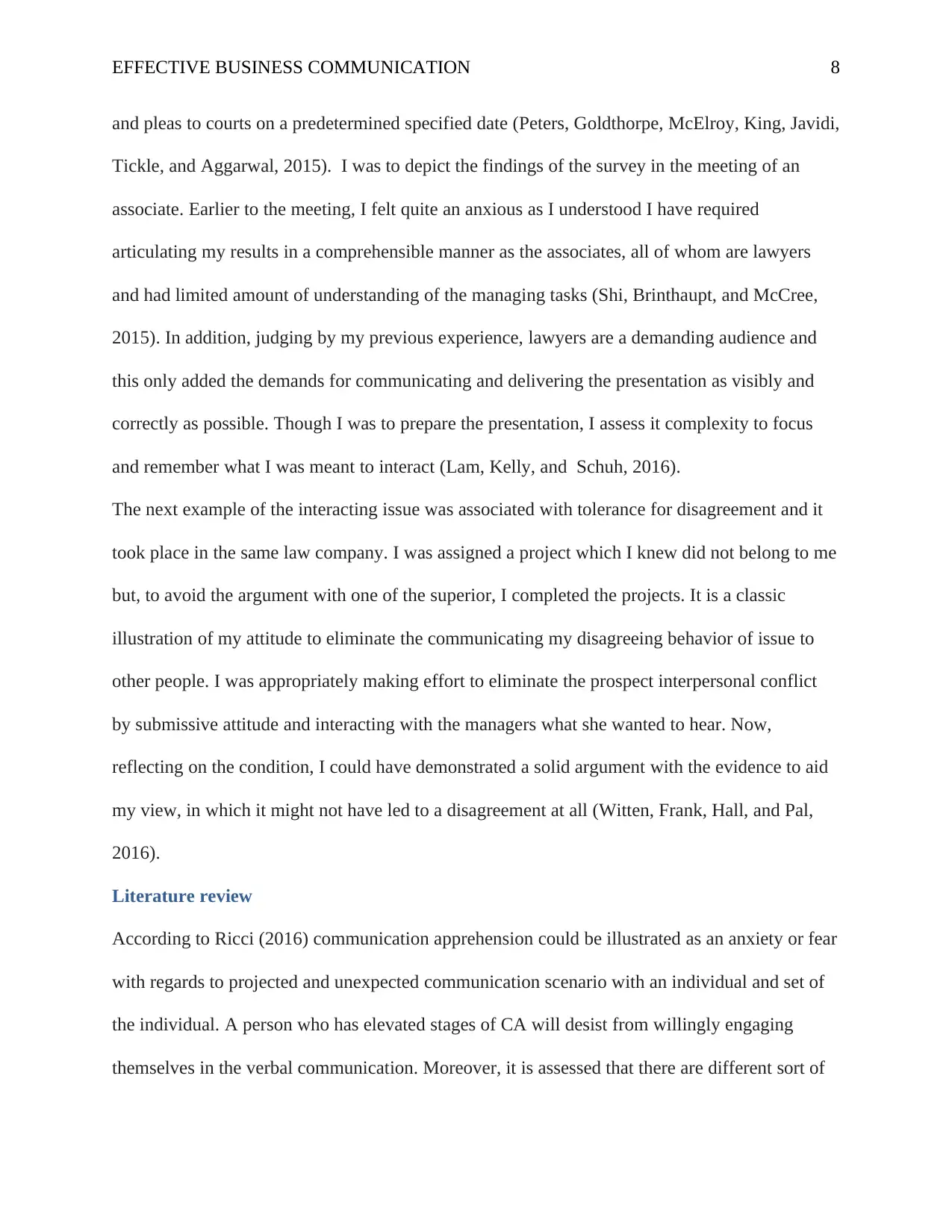
EFFECTIVE BUSINESS COMMUNICATION 8
and pleas to courts on a predetermined specified date (Peters, Goldthorpe, McElroy, King, Javidi,
Tickle, and Aggarwal, 2015). I was to depict the findings of the survey in the meeting of an
associate. Earlier to the meeting, I felt quite an anxious as I understood I have required
articulating my results in a comprehensible manner as the associates, all of whom are lawyers
and had limited amount of understanding of the managing tasks (Shi, Brinthaupt, and McCree,
2015). In addition, judging by my previous experience, lawyers are a demanding audience and
this only added the demands for communicating and delivering the presentation as visibly and
correctly as possible. Though I was to prepare the presentation, I assess it complexity to focus
and remember what I was meant to interact (Lam, Kelly, and Schuh, 2016).
The next example of the interacting issue was associated with tolerance for disagreement and it
took place in the same law company. I was assigned a project which I knew did not belong to me
but, to avoid the argument with one of the superior, I completed the projects. It is a classic
illustration of my attitude to eliminate the communicating my disagreeing behavior of issue to
other people. I was appropriately making effort to eliminate the prospect interpersonal conflict
by submissive attitude and interacting with the managers what she wanted to hear. Now,
reflecting on the condition, I could have demonstrated a solid argument with the evidence to aid
my view, in which it might not have led to a disagreement at all (Witten, Frank, Hall, and Pal,
2016).
Literature review
According to Ricci (2016) communication apprehension could be illustrated as an anxiety or fear
with regards to projected and unexpected communication scenario with an individual and set of
the individual. A person who has elevated stages of CA will desist from willingly engaging
themselves in the verbal communication. Moreover, it is assessed that there are different sort of
and pleas to courts on a predetermined specified date (Peters, Goldthorpe, McElroy, King, Javidi,
Tickle, and Aggarwal, 2015). I was to depict the findings of the survey in the meeting of an
associate. Earlier to the meeting, I felt quite an anxious as I understood I have required
articulating my results in a comprehensible manner as the associates, all of whom are lawyers
and had limited amount of understanding of the managing tasks (Shi, Brinthaupt, and McCree,
2015). In addition, judging by my previous experience, lawyers are a demanding audience and
this only added the demands for communicating and delivering the presentation as visibly and
correctly as possible. Though I was to prepare the presentation, I assess it complexity to focus
and remember what I was meant to interact (Lam, Kelly, and Schuh, 2016).
The next example of the interacting issue was associated with tolerance for disagreement and it
took place in the same law company. I was assigned a project which I knew did not belong to me
but, to avoid the argument with one of the superior, I completed the projects. It is a classic
illustration of my attitude to eliminate the communicating my disagreeing behavior of issue to
other people. I was appropriately making effort to eliminate the prospect interpersonal conflict
by submissive attitude and interacting with the managers what she wanted to hear. Now,
reflecting on the condition, I could have demonstrated a solid argument with the evidence to aid
my view, in which it might not have led to a disagreement at all (Witten, Frank, Hall, and Pal,
2016).
Literature review
According to Ricci (2016) communication apprehension could be illustrated as an anxiety or fear
with regards to projected and unexpected communication scenario with an individual and set of
the individual. A person who has elevated stages of CA will desist from willingly engaging
themselves in the verbal communication. Moreover, it is assessed that there are different sort of
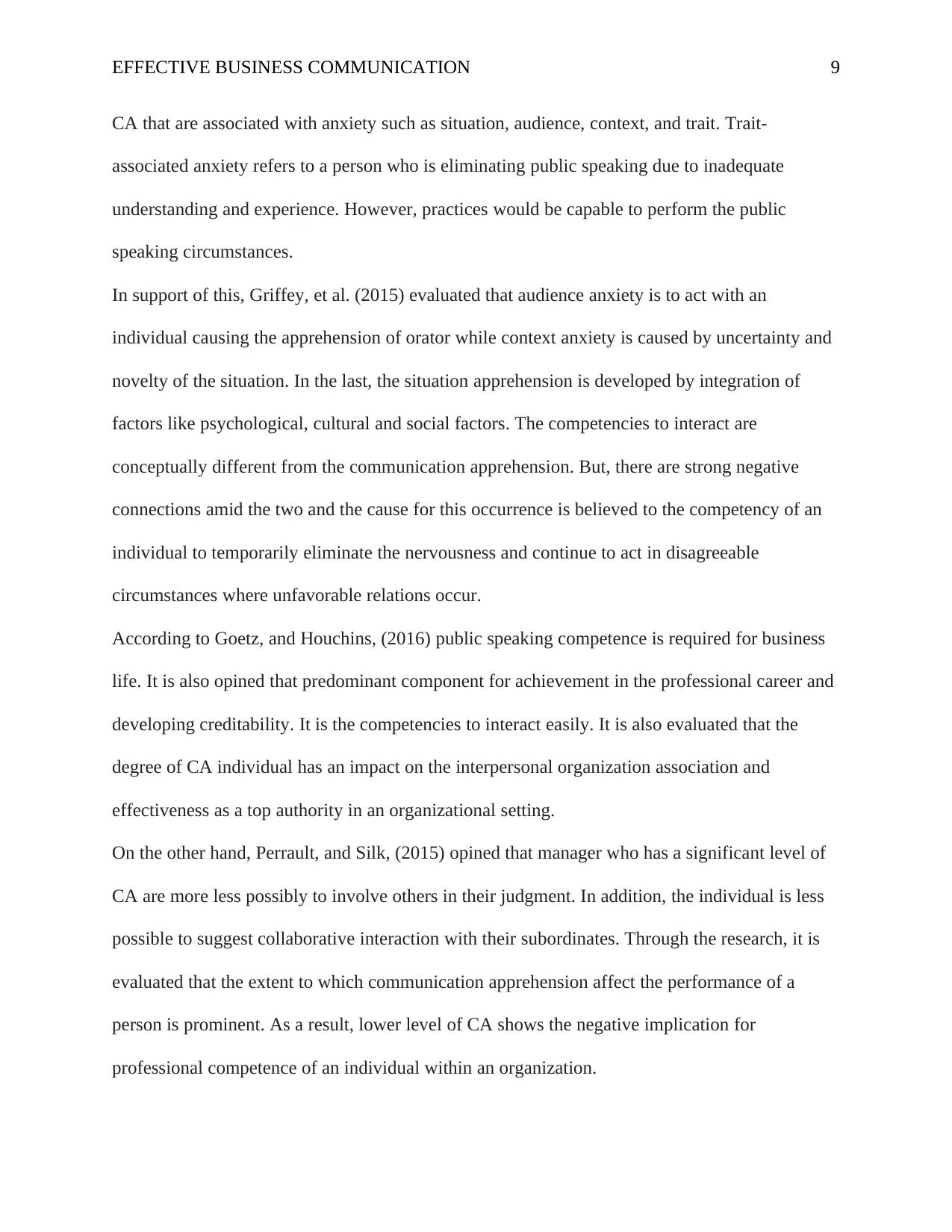
EFFECTIVE BUSINESS COMMUNICATION 9
CA that are associated with anxiety such as situation, audience, context, and trait. Trait-
associated anxiety refers to a person who is eliminating public speaking due to inadequate
understanding and experience. However, practices would be capable to perform the public
speaking circumstances.
In support of this, Griffey, et al. (2015) evaluated that audience anxiety is to act with an
individual causing the apprehension of orator while context anxiety is caused by uncertainty and
novelty of the situation. In the last, the situation apprehension is developed by integration of
factors like psychological, cultural and social factors. The competencies to interact are
conceptually different from the communication apprehension. But, there are strong negative
connections amid the two and the cause for this occurrence is believed to the competency of an
individual to temporarily eliminate the nervousness and continue to act in disagreeable
circumstances where unfavorable relations occur.
According to Goetz, and Houchins, (2016) public speaking competence is required for business
life. It is also opined that predominant component for achievement in the professional career and
developing creditability. It is the competencies to interact easily. It is also evaluated that the
degree of CA individual has an impact on the interpersonal organization association and
effectiveness as a top authority in an organizational setting.
On the other hand, Perrault, and Silk, (2015) opined that manager who has a significant level of
CA are more less possibly to involve others in their judgment. In addition, the individual is less
possible to suggest collaborative interaction with their subordinates. Through the research, it is
evaluated that the extent to which communication apprehension affect the performance of a
person is prominent. As a result, lower level of CA shows the negative implication for
professional competence of an individual within an organization.
CA that are associated with anxiety such as situation, audience, context, and trait. Trait-
associated anxiety refers to a person who is eliminating public speaking due to inadequate
understanding and experience. However, practices would be capable to perform the public
speaking circumstances.
In support of this, Griffey, et al. (2015) evaluated that audience anxiety is to act with an
individual causing the apprehension of orator while context anxiety is caused by uncertainty and
novelty of the situation. In the last, the situation apprehension is developed by integration of
factors like psychological, cultural and social factors. The competencies to interact are
conceptually different from the communication apprehension. But, there are strong negative
connections amid the two and the cause for this occurrence is believed to the competency of an
individual to temporarily eliminate the nervousness and continue to act in disagreeable
circumstances where unfavorable relations occur.
According to Goetz, and Houchins, (2016) public speaking competence is required for business
life. It is also opined that predominant component for achievement in the professional career and
developing creditability. It is the competencies to interact easily. It is also evaluated that the
degree of CA individual has an impact on the interpersonal organization association and
effectiveness as a top authority in an organizational setting.
On the other hand, Perrault, and Silk, (2015) opined that manager who has a significant level of
CA are more less possibly to involve others in their judgment. In addition, the individual is less
possible to suggest collaborative interaction with their subordinates. Through the research, it is
evaluated that the extent to which communication apprehension affect the performance of a
person is prominent. As a result, lower level of CA shows the negative implication for
professional competence of an individual within an organization.

EFFECTIVE BUSINESS COMMUNICATION 10
As per the view of Austi and Pinkleton, (2015) the tolerance for disagreement considers the
group communication in an organizational setting. Disagreeing is circumstantially reliant
meaning that the manner one disagrees can be different but it is depending on the opponent
person in the disagreement. For example, family members and colleagues in which the
disagreement is taking place and whether it is disagreeing online or face to face. The background
of the respondents, their role in an organization and their communication style is the factor that
influences the formation of disagreement.
In support of this, Evans, Hearn, Uhlemann, and Ivey (2017) evaluated that the theoretical
structure of interpersonal communication and conflict and disagreement is not unequivocal
because there are different elements, which influence the situation, whether a discussion evolves
into conflicts or disagreement. It is also addressed that there are four interpersonal
communication factors which influence the origin of possible disagreement and conflict within
an organization. These factors are non-verbal communication, verbal communication, listening
and emotions in communication. It is also addressed that there are several verbal communication
styles and addressed different factors affecting the communication that were expressiveness,
supportiveness, argumentativeness, expressiveness, preciseness, assuredness and verbal
aggressiveness. These factors could have an impact on the communications and particularly in
the business context. The factors indicate how workforces observe their superior. At the
workplace, team commitment, and knowledge sharing is highly persuaded by the communication
style of managers.
As per the view of Morgan et al. (2015) the effective communication considers different skills
that an organization seeks in the managers and it is directly associated with team efficacy and
also gains the opportunity for promotion. When interacting with different sort of circumstances
As per the view of Austi and Pinkleton, (2015) the tolerance for disagreement considers the
group communication in an organizational setting. Disagreeing is circumstantially reliant
meaning that the manner one disagrees can be different but it is depending on the opponent
person in the disagreement. For example, family members and colleagues in which the
disagreement is taking place and whether it is disagreeing online or face to face. The background
of the respondents, their role in an organization and their communication style is the factor that
influences the formation of disagreement.
In support of this, Evans, Hearn, Uhlemann, and Ivey (2017) evaluated that the theoretical
structure of interpersonal communication and conflict and disagreement is not unequivocal
because there are different elements, which influence the situation, whether a discussion evolves
into conflicts or disagreement. It is also addressed that there are four interpersonal
communication factors which influence the origin of possible disagreement and conflict within
an organization. These factors are non-verbal communication, verbal communication, listening
and emotions in communication. It is also addressed that there are several verbal communication
styles and addressed different factors affecting the communication that were expressiveness,
supportiveness, argumentativeness, expressiveness, preciseness, assuredness and verbal
aggressiveness. These factors could have an impact on the communications and particularly in
the business context. The factors indicate how workforces observe their superior. At the
workplace, team commitment, and knowledge sharing is highly persuaded by the communication
style of managers.
As per the view of Morgan et al. (2015) the effective communication considers different skills
that an organization seeks in the managers and it is directly associated with team efficacy and
also gains the opportunity for promotion. When interacting with different sort of circumstances
Secure Best Marks with AI Grader
Need help grading? Try our AI Grader for instant feedback on your assignments.
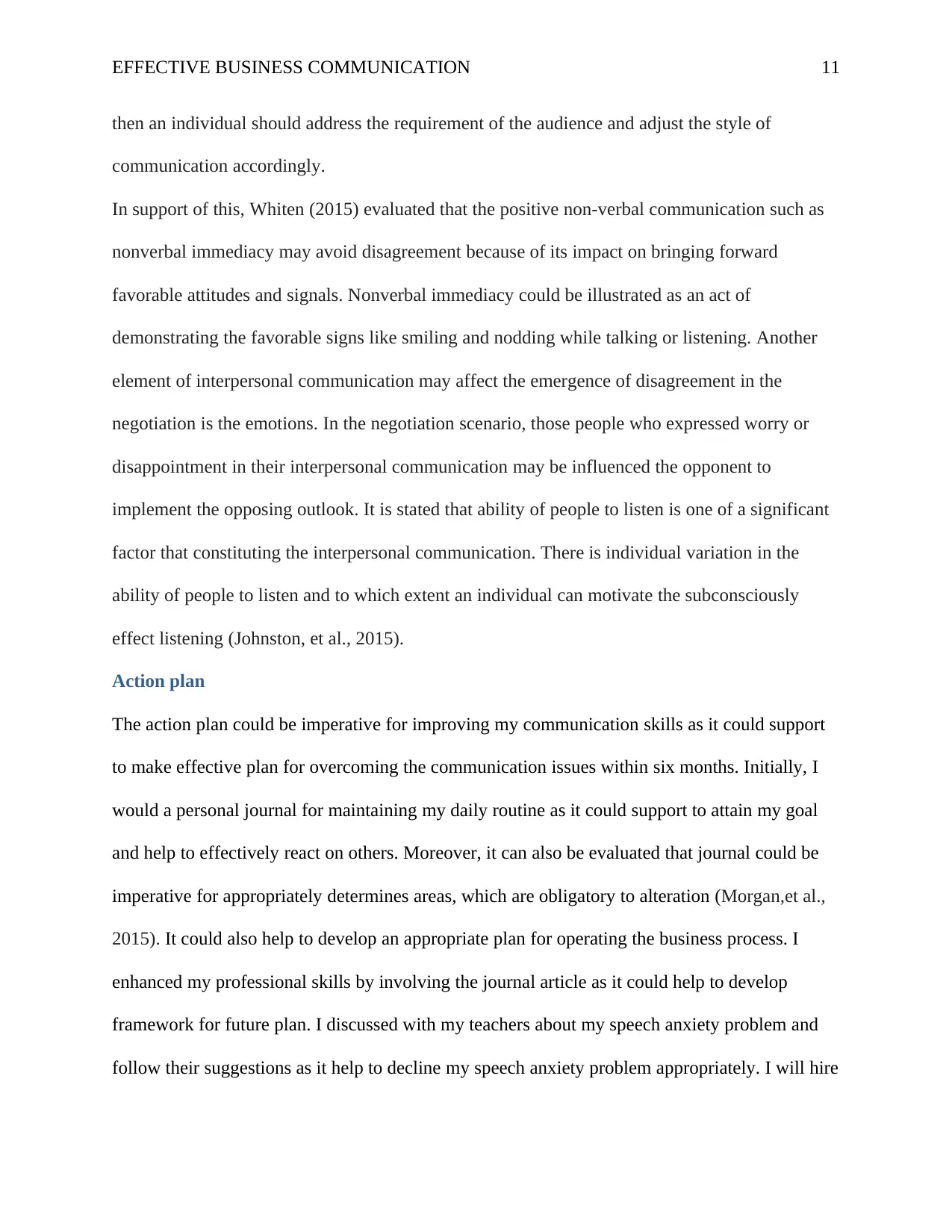
EFFECTIVE BUSINESS COMMUNICATION 11
then an individual should address the requirement of the audience and adjust the style of
communication accordingly.
In support of this, Whiten (2015) evaluated that the positive non-verbal communication such as
nonverbal immediacy may avoid disagreement because of its impact on bringing forward
favorable attitudes and signals. Nonverbal immediacy could be illustrated as an act of
demonstrating the favorable signs like smiling and nodding while talking or listening. Another
element of interpersonal communication may affect the emergence of disagreement in the
negotiation is the emotions. In the negotiation scenario, those people who expressed worry or
disappointment in their interpersonal communication may be influenced the opponent to
implement the opposing outlook. It is stated that ability of people to listen is one of a significant
factor that constituting the interpersonal communication. There is individual variation in the
ability of people to listen and to which extent an individual can motivate the subconsciously
effect listening (Johnston, et al., 2015).
Action plan
The action plan could be imperative for improving my communication skills as it could support
to make effective plan for overcoming the communication issues within six months. Initially, I
would a personal journal for maintaining my daily routine as it could support to attain my goal
and help to effectively react on others. Moreover, it can also be evaluated that journal could be
imperative for appropriately determines areas, which are obligatory to alteration (Morgan,et al.,
2015). It could also help to develop an appropriate plan for operating the business process. I
enhanced my professional skills by involving the journal article as it could help to develop
framework for future plan. I discussed with my teachers about my speech anxiety problem and
follow their suggestions as it help to decline my speech anxiety problem appropriately. I will hire
then an individual should address the requirement of the audience and adjust the style of
communication accordingly.
In support of this, Whiten (2015) evaluated that the positive non-verbal communication such as
nonverbal immediacy may avoid disagreement because of its impact on bringing forward
favorable attitudes and signals. Nonverbal immediacy could be illustrated as an act of
demonstrating the favorable signs like smiling and nodding while talking or listening. Another
element of interpersonal communication may affect the emergence of disagreement in the
negotiation is the emotions. In the negotiation scenario, those people who expressed worry or
disappointment in their interpersonal communication may be influenced the opponent to
implement the opposing outlook. It is stated that ability of people to listen is one of a significant
factor that constituting the interpersonal communication. There is individual variation in the
ability of people to listen and to which extent an individual can motivate the subconsciously
effect listening (Johnston, et al., 2015).
Action plan
The action plan could be imperative for improving my communication skills as it could support
to make effective plan for overcoming the communication issues within six months. Initially, I
would a personal journal for maintaining my daily routine as it could support to attain my goal
and help to effectively react on others. Moreover, it can also be evaluated that journal could be
imperative for appropriately determines areas, which are obligatory to alteration (Morgan,et al.,
2015). It could also help to develop an appropriate plan for operating the business process. I
enhanced my professional skills by involving the journal article as it could help to develop
framework for future plan. I discussed with my teachers about my speech anxiety problem and
follow their suggestions as it help to decline my speech anxiety problem appropriately. I will hire
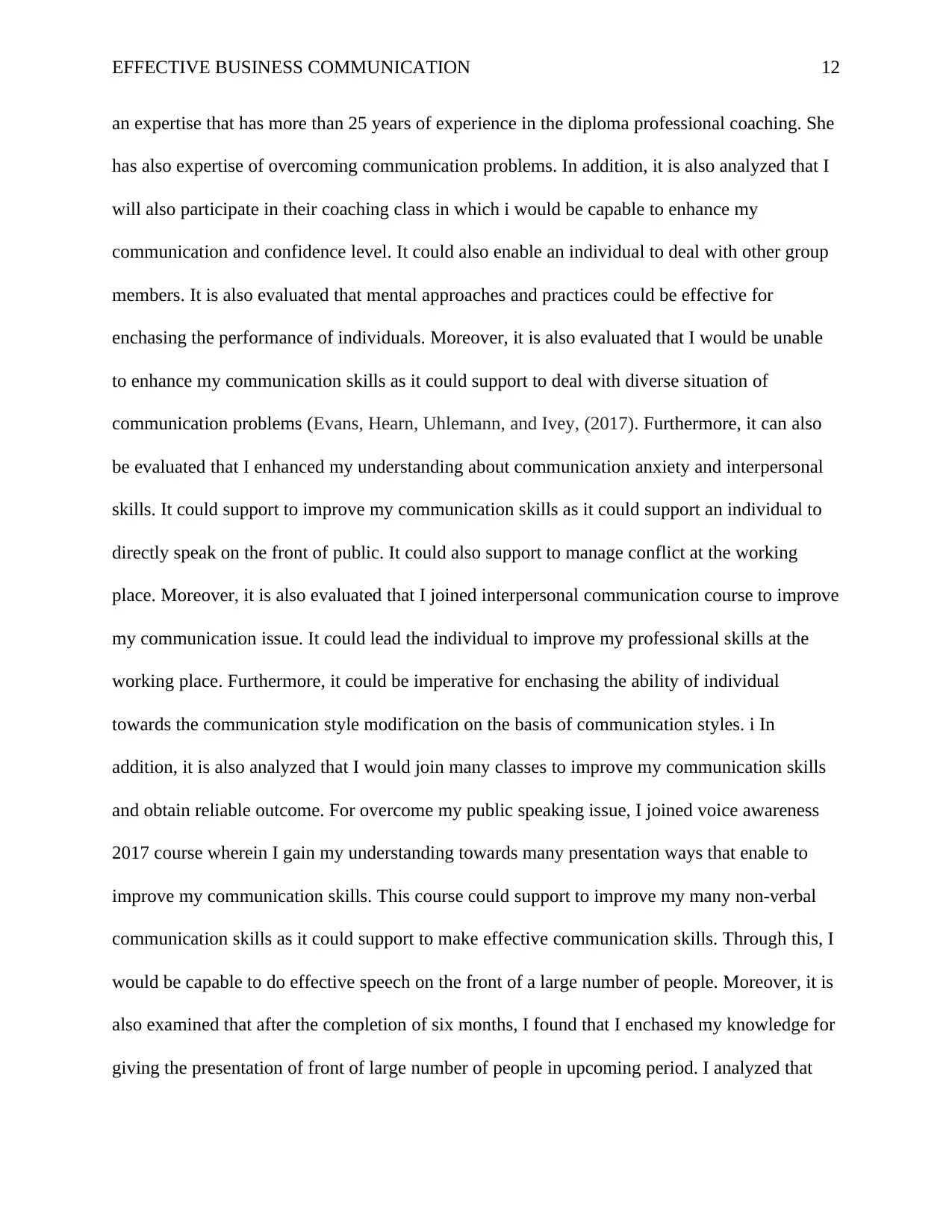
EFFECTIVE BUSINESS COMMUNICATION 12
an expertise that has more than 25 years of experience in the diploma professional coaching. She
has also expertise of overcoming communication problems. In addition, it is also analyzed that I
will also participate in their coaching class in which i would be capable to enhance my
communication and confidence level. It could also enable an individual to deal with other group
members. It is also evaluated that mental approaches and practices could be effective for
enchasing the performance of individuals. Moreover, it is also evaluated that I would be unable
to enhance my communication skills as it could support to deal with diverse situation of
communication problems (Evans, Hearn, Uhlemann, and Ivey, (2017). Furthermore, it can also
be evaluated that I enhanced my understanding about communication anxiety and interpersonal
skills. It could support to improve my communication skills as it could support an individual to
directly speak on the front of public. It could also support to manage conflict at the working
place. Moreover, it is also evaluated that I joined interpersonal communication course to improve
my communication issue. It could lead the individual to improve my professional skills at the
working place. Furthermore, it could be imperative for enchasing the ability of individual
towards the communication style modification on the basis of communication styles. i In
addition, it is also analyzed that I would join many classes to improve my communication skills
and obtain reliable outcome. For overcome my public speaking issue, I joined voice awareness
2017 course wherein I gain my understanding towards many presentation ways that enable to
improve my communication skills. This course could support to improve my many non-verbal
communication skills as it could support to make effective communication skills. Through this, I
would be capable to do effective speech on the front of a large number of people. Moreover, it is
also examined that after the completion of six months, I found that I enchased my knowledge for
giving the presentation of front of large number of people in upcoming period. I analyzed that
an expertise that has more than 25 years of experience in the diploma professional coaching. She
has also expertise of overcoming communication problems. In addition, it is also analyzed that I
will also participate in their coaching class in which i would be capable to enhance my
communication and confidence level. It could also enable an individual to deal with other group
members. It is also evaluated that mental approaches and practices could be effective for
enchasing the performance of individuals. Moreover, it is also evaluated that I would be unable
to enhance my communication skills as it could support to deal with diverse situation of
communication problems (Evans, Hearn, Uhlemann, and Ivey, (2017). Furthermore, it can also
be evaluated that I enhanced my understanding about communication anxiety and interpersonal
skills. It could support to improve my communication skills as it could support an individual to
directly speak on the front of public. It could also support to manage conflict at the working
place. Moreover, it is also evaluated that I joined interpersonal communication course to improve
my communication issue. It could lead the individual to improve my professional skills at the
working place. Furthermore, it could be imperative for enchasing the ability of individual
towards the communication style modification on the basis of communication styles. i In
addition, it is also analyzed that I would join many classes to improve my communication skills
and obtain reliable outcome. For overcome my public speaking issue, I joined voice awareness
2017 course wherein I gain my understanding towards many presentation ways that enable to
improve my communication skills. This course could support to improve my many non-verbal
communication skills as it could support to make effective communication skills. Through this, I
would be capable to do effective speech on the front of a large number of people. Moreover, it is
also examined that after the completion of six months, I found that I enchased my knowledge for
giving the presentation of front of large number of people in upcoming period. I analyzed that

EFFECTIVE BUSINESS COMMUNICATION 13
learning communication could be effective for enchasing my communication skills and
interpersonal skills as it could be imperative in future to deal with conflict and communication
issues.
Figure 1 Gantt chart of the action plan
Gantt Chart showing Action Plan
Jun-
18
Jul-
18
Aug-
18
Sep-
18
Oct-
18
Nov-
18
Reading Journal articles
Developing Memo
Discussing with Mentor
going on crowd
Participating in Cultural Fest
Weekly communication with strangers
Conclusion
From the above discussion, it can be summarized that five diagnostic tools could be imperative
for improving the communication problems. Moreover, there are two communication issues that
are measured by the communication tools like public speaking anxiety and tolerance for
disagreement. There are two theories that could be effective for dealing with such kind of issues
such as interpersonal communication disagreement and communication apprehension. It can also
be summarized that internal communication could consider many things like verbal and non-
verbal communication, listing, and communication emotion. In addition, it can also analyze that
communication apprehension could use to determine the diverse kinds of CA and the capability
learning communication could be effective for enchasing my communication skills and
interpersonal skills as it could be imperative in future to deal with conflict and communication
issues.
Figure 1 Gantt chart of the action plan
Gantt Chart showing Action Plan
Jun-
18
Jul-
18
Aug-
18
Sep-
18
Oct-
18
Nov-
18
Reading Journal articles
Developing Memo
Discussing with Mentor
going on crowd
Participating in Cultural Fest
Weekly communication with strangers
Conclusion
From the above discussion, it can be summarized that five diagnostic tools could be imperative
for improving the communication problems. Moreover, there are two communication issues that
are measured by the communication tools like public speaking anxiety and tolerance for
disagreement. There are two theories that could be effective for dealing with such kind of issues
such as interpersonal communication disagreement and communication apprehension. It can also
be summarized that internal communication could consider many things like verbal and non-
verbal communication, listing, and communication emotion. In addition, it can also analyze that
communication apprehension could use to determine the diverse kinds of CA and the capability
Paraphrase This Document
Need a fresh take? Get an instant paraphrase of this document with our AI Paraphraser
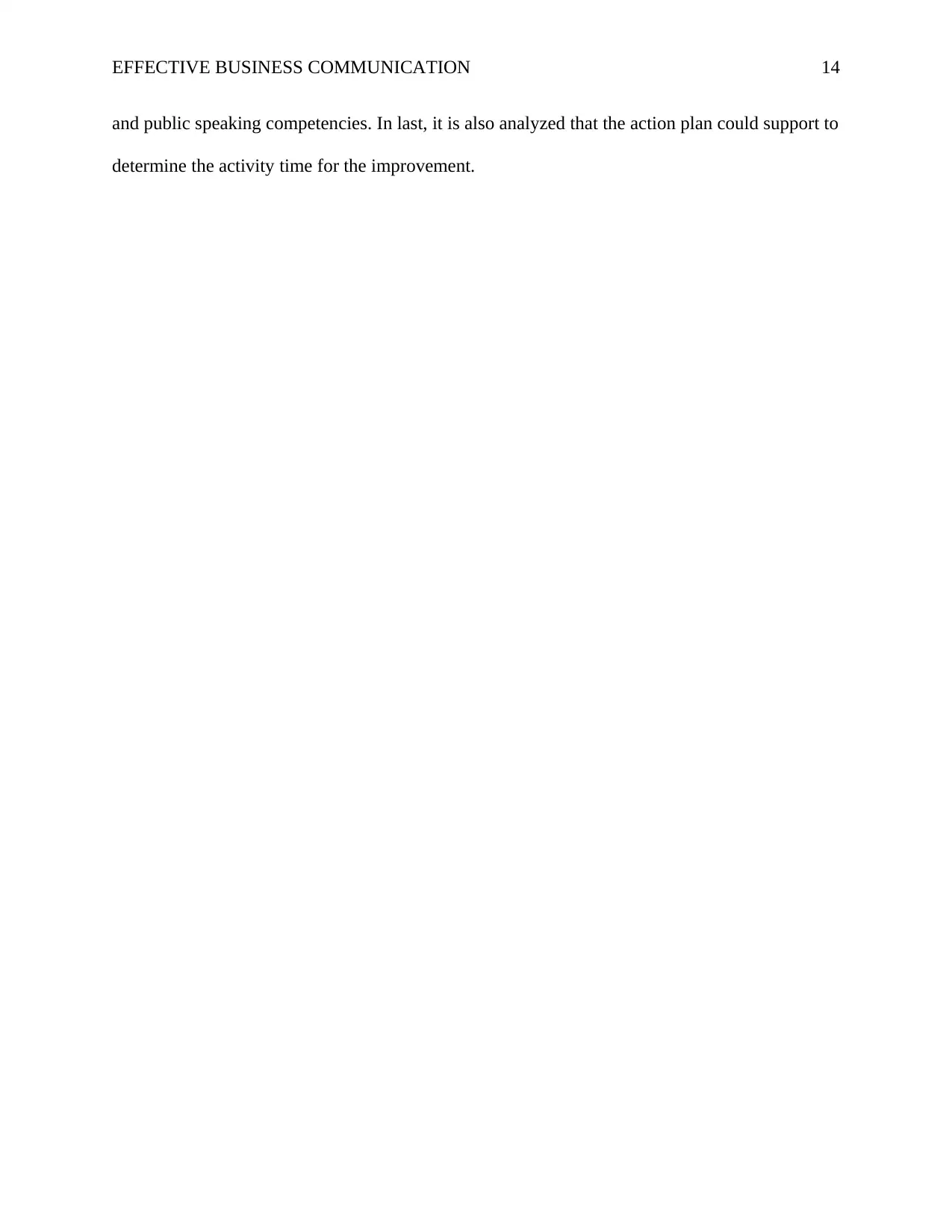
EFFECTIVE BUSINESS COMMUNICATION 14
and public speaking competencies. In last, it is also analyzed that the action plan could support to
determine the activity time for the improvement.
and public speaking competencies. In last, it is also analyzed that the action plan could support to
determine the activity time for the improvement.
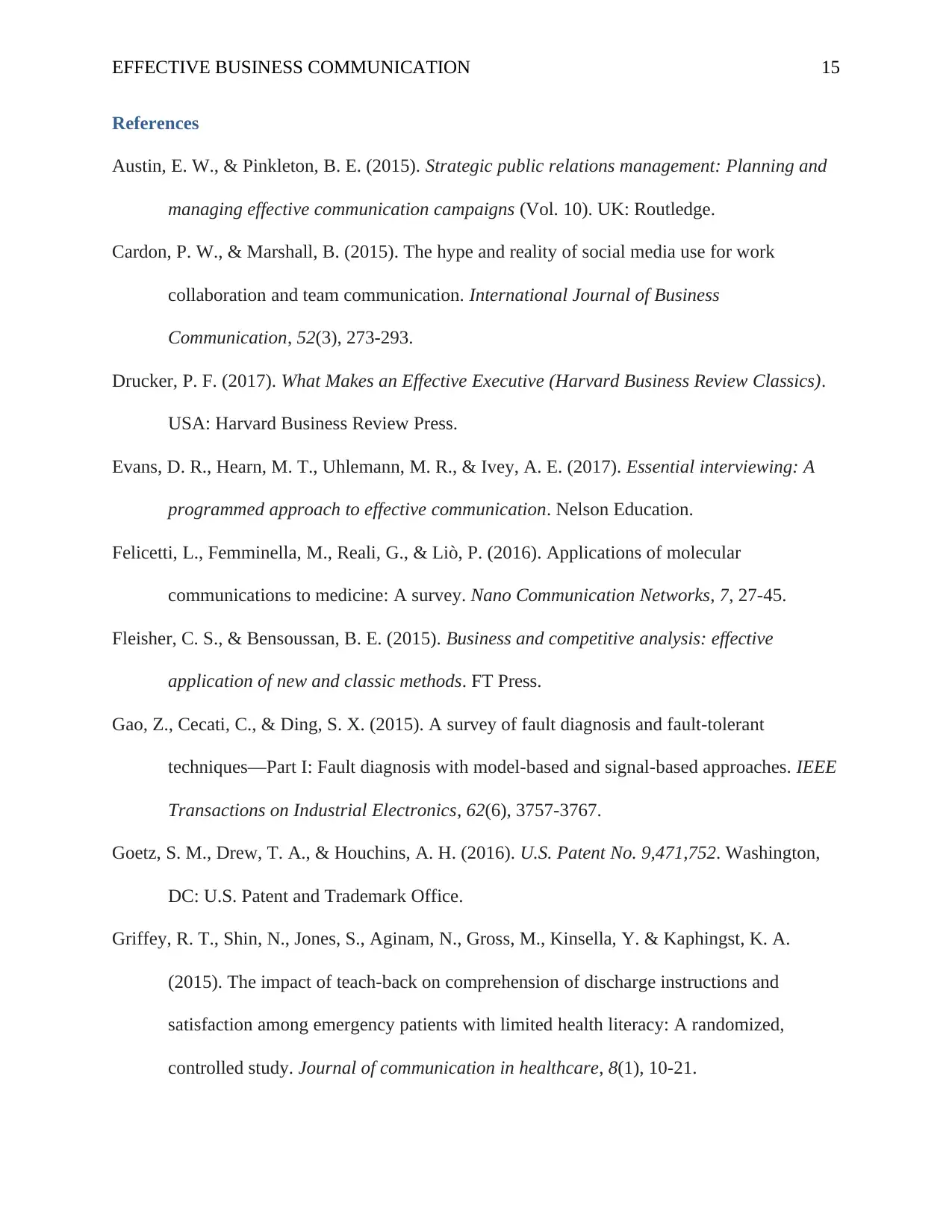
EFFECTIVE BUSINESS COMMUNICATION 15
References
Austin, E. W., & Pinkleton, B. E. (2015). Strategic public relations management: Planning and
managing effective communication campaigns (Vol. 10). UK: Routledge.
Cardon, P. W., & Marshall, B. (2015). The hype and reality of social media use for work
collaboration and team communication. International Journal of Business
Communication, 52(3), 273-293.
Drucker, P. F. (2017). What Makes an Effective Executive (Harvard Business Review Classics).
USA: Harvard Business Review Press.
Evans, D. R., Hearn, M. T., Uhlemann, M. R., & Ivey, A. E. (2017). Essential interviewing: A
programmed approach to effective communication. Nelson Education.
Felicetti, L., Femminella, M., Reali, G., & Liò, P. (2016). Applications of molecular
communications to medicine: A survey. Nano Communication Networks, 7, 27-45.
Fleisher, C. S., & Bensoussan, B. E. (2015). Business and competitive analysis: effective
application of new and classic methods. FT Press.
Gao, Z., Cecati, C., & Ding, S. X. (2015). A survey of fault diagnosis and fault-tolerant
techniques—Part I: Fault diagnosis with model-based and signal-based approaches. IEEE
Transactions on Industrial Electronics, 62(6), 3757-3767.
Goetz, S. M., Drew, T. A., & Houchins, A. H. (2016). U.S. Patent No. 9,471,752. Washington,
DC: U.S. Patent and Trademark Office.
Griffey, R. T., Shin, N., Jones, S., Aginam, N., Gross, M., Kinsella, Y. & Kaphingst, K. A.
(2015). The impact of teach-back on comprehension of discharge instructions and
satisfaction among emergency patients with limited health literacy: A randomized,
controlled study. Journal of communication in healthcare, 8(1), 10-21.
References
Austin, E. W., & Pinkleton, B. E. (2015). Strategic public relations management: Planning and
managing effective communication campaigns (Vol. 10). UK: Routledge.
Cardon, P. W., & Marshall, B. (2015). The hype and reality of social media use for work
collaboration and team communication. International Journal of Business
Communication, 52(3), 273-293.
Drucker, P. F. (2017). What Makes an Effective Executive (Harvard Business Review Classics).
USA: Harvard Business Review Press.
Evans, D. R., Hearn, M. T., Uhlemann, M. R., & Ivey, A. E. (2017). Essential interviewing: A
programmed approach to effective communication. Nelson Education.
Felicetti, L., Femminella, M., Reali, G., & Liò, P. (2016). Applications of molecular
communications to medicine: A survey. Nano Communication Networks, 7, 27-45.
Fleisher, C. S., & Bensoussan, B. E. (2015). Business and competitive analysis: effective
application of new and classic methods. FT Press.
Gao, Z., Cecati, C., & Ding, S. X. (2015). A survey of fault diagnosis and fault-tolerant
techniques—Part I: Fault diagnosis with model-based and signal-based approaches. IEEE
Transactions on Industrial Electronics, 62(6), 3757-3767.
Goetz, S. M., Drew, T. A., & Houchins, A. H. (2016). U.S. Patent No. 9,471,752. Washington,
DC: U.S. Patent and Trademark Office.
Griffey, R. T., Shin, N., Jones, S., Aginam, N., Gross, M., Kinsella, Y. & Kaphingst, K. A.
(2015). The impact of teach-back on comprehension of discharge instructions and
satisfaction among emergency patients with limited health literacy: A randomized,
controlled study. Journal of communication in healthcare, 8(1), 10-21.

EFFECTIVE BUSINESS COMMUNICATION 16
Johnston, M. J., King, D., Arora, S., Behar, N., Athanasiou, T., Sevdalis, N., & Darzi, A. (2015).
Smartphones let surgeons know WhatsApp: an analysis of communication in emergency
surgical teams. The American Journal of Surgery, 209(1), 45-51.
Kernbach, S., Eppler, M. J., & Bresciani, S. (2015). The use of visualization in the
communication of business strategies: An experimental evaluation. International Journal
of Business Communication, 52(2), 164-187.
Mangione-Smith, R., Zhou, C., Robinson, J. D., Taylor, J. A., Elliott, M. N., & Heritage, J.
(2015). Communication practices and antibiotic use for acute respiratory tract infections
in children. The Annals of Family Medicine, 13(3), 221-227.
Mickle, J. A., Smith, M. W., & Chilton, J. H. (2016). U.S. Patent No. 9,407,960. Washington,
DC: U.S. Patent and Trademark Office.
Mohn, C., Sekula, C. A., Kakumanu, S., Tuttle, O. R., Fuglewicz, D. P., Anderson, P. S., &
Martin Jr, T. J. (2017). U.S. Patent No. 9,754,499. Washington, DC: U.S. Patent and
Trademark Office.
Morgan, T. J., Uomini, N. T., Rendell, L. E., Chouinard-Thuly, L., Street, S. E., Lewis, H. M., ...
& Whiten, A. (2015). Experimental evidence for the co-evolution of hominin tool-
making teaching and language. Nature Communications, 6, 6029.
Nolen-Hoeksema, S., & Rector, N. A. (2015). Abnormal psychology. Boston: McGraw-Hill.
Oommen, D. (2014). The relationships among perceptions of social support, Intercultural
Communication Apprehension (ICA), and conflict management preferences in the
context of cultural adaptation. Journal of Intercultural Communication Research, 43(3),
215-237.
Johnston, M. J., King, D., Arora, S., Behar, N., Athanasiou, T., Sevdalis, N., & Darzi, A. (2015).
Smartphones let surgeons know WhatsApp: an analysis of communication in emergency
surgical teams. The American Journal of Surgery, 209(1), 45-51.
Kernbach, S., Eppler, M. J., & Bresciani, S. (2015). The use of visualization in the
communication of business strategies: An experimental evaluation. International Journal
of Business Communication, 52(2), 164-187.
Mangione-Smith, R., Zhou, C., Robinson, J. D., Taylor, J. A., Elliott, M. N., & Heritage, J.
(2015). Communication practices and antibiotic use for acute respiratory tract infections
in children. The Annals of Family Medicine, 13(3), 221-227.
Mickle, J. A., Smith, M. W., & Chilton, J. H. (2016). U.S. Patent No. 9,407,960. Washington,
DC: U.S. Patent and Trademark Office.
Mohn, C., Sekula, C. A., Kakumanu, S., Tuttle, O. R., Fuglewicz, D. P., Anderson, P. S., &
Martin Jr, T. J. (2017). U.S. Patent No. 9,754,499. Washington, DC: U.S. Patent and
Trademark Office.
Morgan, T. J., Uomini, N. T., Rendell, L. E., Chouinard-Thuly, L., Street, S. E., Lewis, H. M., ...
& Whiten, A. (2015). Experimental evidence for the co-evolution of hominin tool-
making teaching and language. Nature Communications, 6, 6029.
Nolen-Hoeksema, S., & Rector, N. A. (2015). Abnormal psychology. Boston: McGraw-Hill.
Oommen, D. (2014). The relationships among perceptions of social support, Intercultural
Communication Apprehension (ICA), and conflict management preferences in the
context of cultural adaptation. Journal of Intercultural Communication Research, 43(3),
215-237.
Secure Best Marks with AI Grader
Need help grading? Try our AI Grader for instant feedback on your assignments.
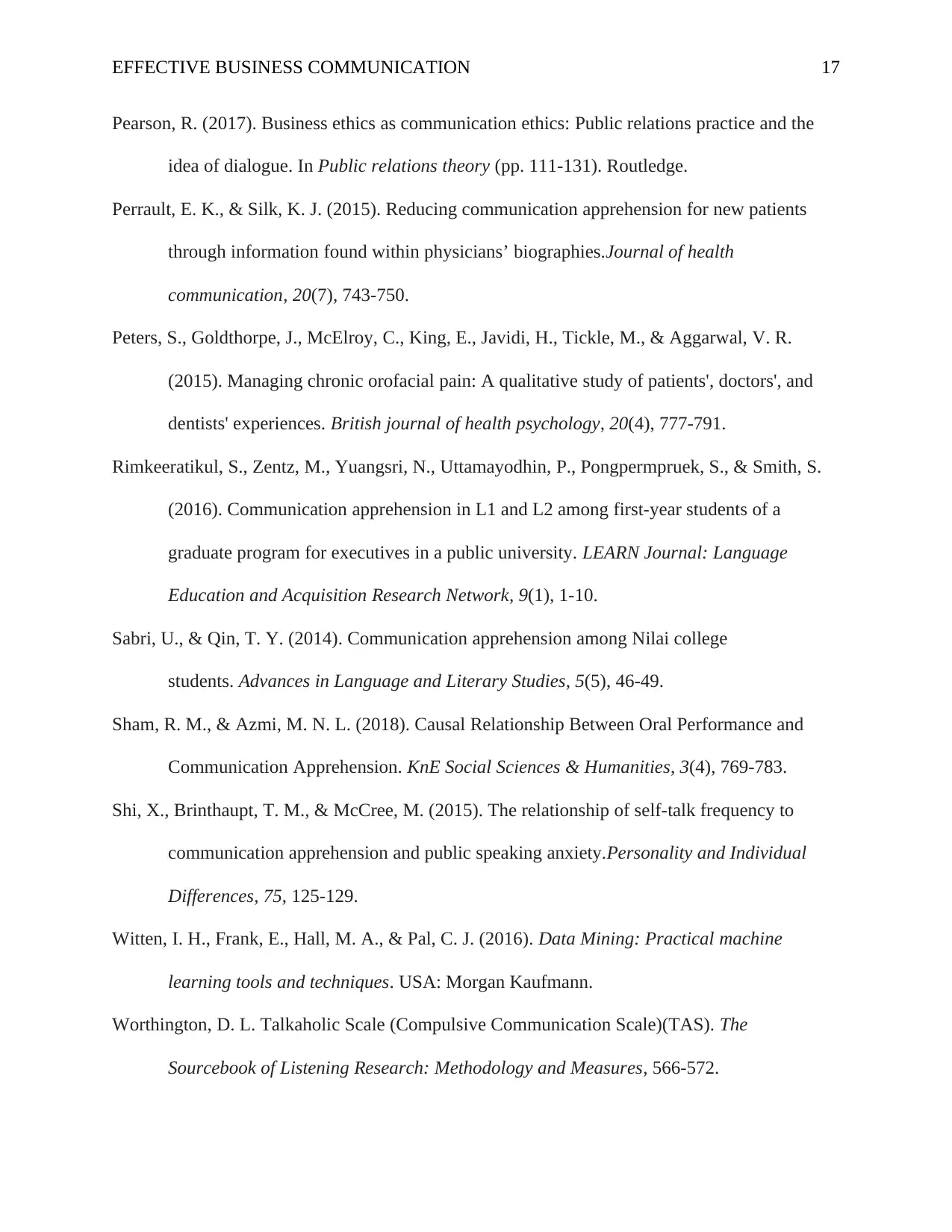
EFFECTIVE BUSINESS COMMUNICATION 17
Pearson, R. (2017). Business ethics as communication ethics: Public relations practice and the
idea of dialogue. In Public relations theory (pp. 111-131). Routledge.
Perrault, E. K., & Silk, K. J. (2015). Reducing communication apprehension for new patients
through information found within physicians’ biographies.Journal of health
communication, 20(7), 743-750.
Peters, S., Goldthorpe, J., McElroy, C., King, E., Javidi, H., Tickle, M., & Aggarwal, V. R.
(2015). Managing chronic orofacial pain: A qualitative study of patients', doctors', and
dentists' experiences. British journal of health psychology, 20(4), 777-791.
Rimkeeratikul, S., Zentz, M., Yuangsri, N., Uttamayodhin, P., Pongpermpruek, S., & Smith, S.
(2016). Communication apprehension in L1 and L2 among first-year students of a
graduate program for executives in a public university. LEARN Journal: Language
Education and Acquisition Research Network, 9(1), 1-10.
Sabri, U., & Qin, T. Y. (2014). Communication apprehension among Nilai college
students. Advances in Language and Literary Studies, 5(5), 46-49.
Sham, R. M., & Azmi, M. N. L. (2018). Causal Relationship Between Oral Performance and
Communication Apprehension. KnE Social Sciences & Humanities, 3(4), 769-783.
Shi, X., Brinthaupt, T. M., & McCree, M. (2015). The relationship of self-talk frequency to
communication apprehension and public speaking anxiety.Personality and Individual
Differences, 75, 125-129.
Witten, I. H., Frank, E., Hall, M. A., & Pal, C. J. (2016). Data Mining: Practical machine
learning tools and techniques. USA: Morgan Kaufmann.
Worthington, D. L. Talkaholic Scale (Compulsive Communication Scale)(TAS). The
Sourcebook of Listening Research: Methodology and Measures, 566-572.
Pearson, R. (2017). Business ethics as communication ethics: Public relations practice and the
idea of dialogue. In Public relations theory (pp. 111-131). Routledge.
Perrault, E. K., & Silk, K. J. (2015). Reducing communication apprehension for new patients
through information found within physicians’ biographies.Journal of health
communication, 20(7), 743-750.
Peters, S., Goldthorpe, J., McElroy, C., King, E., Javidi, H., Tickle, M., & Aggarwal, V. R.
(2015). Managing chronic orofacial pain: A qualitative study of patients', doctors', and
dentists' experiences. British journal of health psychology, 20(4), 777-791.
Rimkeeratikul, S., Zentz, M., Yuangsri, N., Uttamayodhin, P., Pongpermpruek, S., & Smith, S.
(2016). Communication apprehension in L1 and L2 among first-year students of a
graduate program for executives in a public university. LEARN Journal: Language
Education and Acquisition Research Network, 9(1), 1-10.
Sabri, U., & Qin, T. Y. (2014). Communication apprehension among Nilai college
students. Advances in Language and Literary Studies, 5(5), 46-49.
Sham, R. M., & Azmi, M. N. L. (2018). Causal Relationship Between Oral Performance and
Communication Apprehension. KnE Social Sciences & Humanities, 3(4), 769-783.
Shi, X., Brinthaupt, T. M., & McCree, M. (2015). The relationship of self-talk frequency to
communication apprehension and public speaking anxiety.Personality and Individual
Differences, 75, 125-129.
Witten, I. H., Frank, E., Hall, M. A., & Pal, C. J. (2016). Data Mining: Practical machine
learning tools and techniques. USA: Morgan Kaufmann.
Worthington, D. L. Talkaholic Scale (Compulsive Communication Scale)(TAS). The
Sourcebook of Listening Research: Methodology and Measures, 566-572.
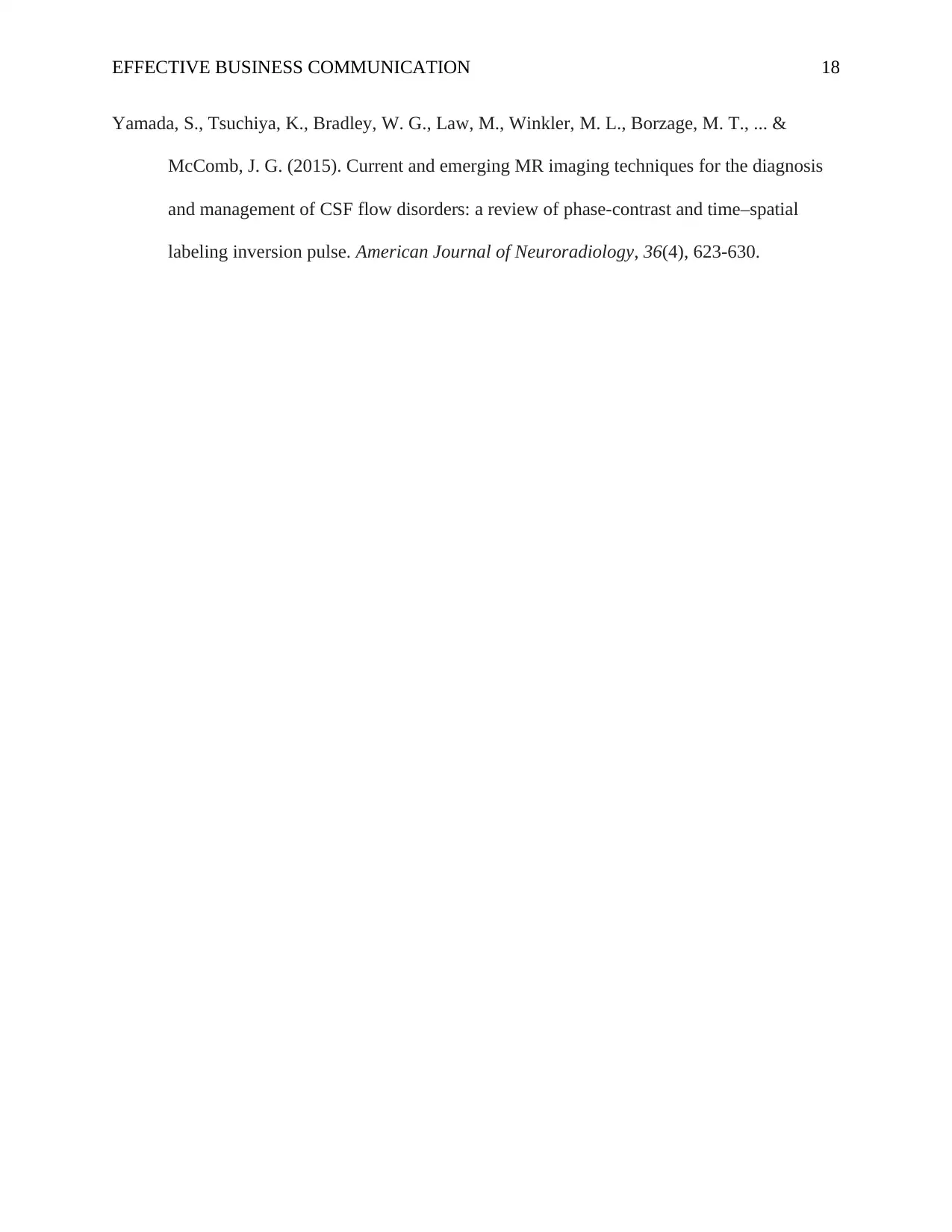
EFFECTIVE BUSINESS COMMUNICATION 18
Yamada, S., Tsuchiya, K., Bradley, W. G., Law, M., Winkler, M. L., Borzage, M. T., ... &
McComb, J. G. (2015). Current and emerging MR imaging techniques for the diagnosis
and management of CSF flow disorders: a review of phase-contrast and time–spatial
labeling inversion pulse. American Journal of Neuroradiology, 36(4), 623-630.
Yamada, S., Tsuchiya, K., Bradley, W. G., Law, M., Winkler, M. L., Borzage, M. T., ... &
McComb, J. G. (2015). Current and emerging MR imaging techniques for the diagnosis
and management of CSF flow disorders: a review of phase-contrast and time–spatial
labeling inversion pulse. American Journal of Neuroradiology, 36(4), 623-630.
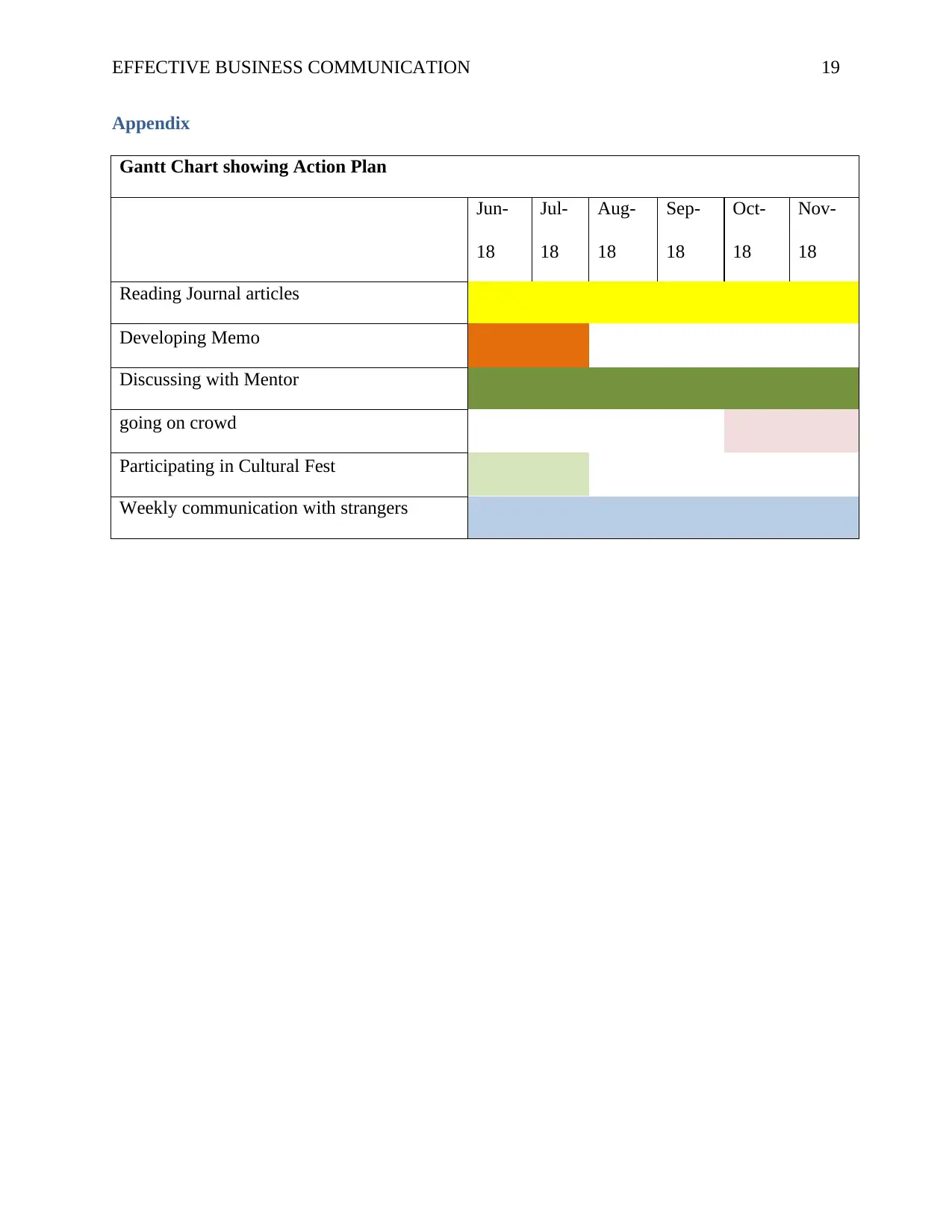
EFFECTIVE BUSINESS COMMUNICATION 19
Appendix
Gantt Chart showing Action Plan
Jun-
18
Jul-
18
Aug-
18
Sep-
18
Oct-
18
Nov-
18
Reading Journal articles
Developing Memo
Discussing with Mentor
going on crowd
Participating in Cultural Fest
Weekly communication with strangers
Appendix
Gantt Chart showing Action Plan
Jun-
18
Jul-
18
Aug-
18
Sep-
18
Oct-
18
Nov-
18
Reading Journal articles
Developing Memo
Discussing with Mentor
going on crowd
Participating in Cultural Fest
Weekly communication with strangers
1 out of 19
Related Documents
Your All-in-One AI-Powered Toolkit for Academic Success.
+13062052269
info@desklib.com
Available 24*7 on WhatsApp / Email
![[object Object]](/_next/static/media/star-bottom.7253800d.svg)
Unlock your academic potential
© 2024 | Zucol Services PVT LTD | All rights reserved.


